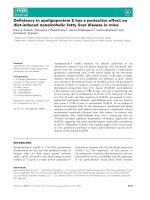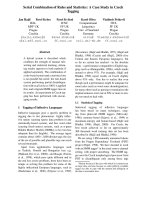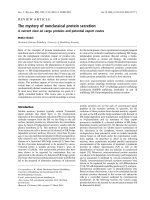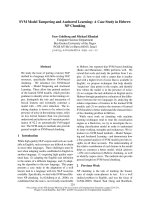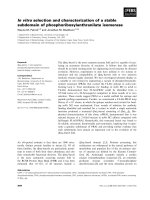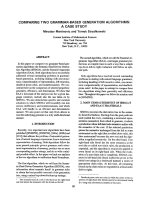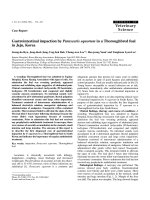Báo cáo khoa học: "Can Document Selection Help Semi-supervised Learning? A Case Study On Event Extraction" potx
Bạn đang xem bản rút gọn của tài liệu. Xem và tải ngay bản đầy đủ của tài liệu tại đây (251.2 KB, 6 trang )
Proceedings of the 49th Annual Meeting of the Association for Computational Linguistics:shortpapers, pages 260–265,
Portland, Oregon, June 19-24, 2011.
c
2011 Association for Computational Linguistics
Can Document Selection Help Semi-supervised Learning?
A Case Study On Event Extraction
Shasha Liao
Ralph Grishman
Computer Science Department
New York University
Abstract
Annotating training data for event
extraction is tedious and labor-intensive.
Most current event extraction tasks rely
on hundreds of annotated documents, but
this is often not enough. In this paper, we
present a novel self-training strategy,
which uses Information Retrieval (IR) to
collect a cluster of related documents as
the resource for bootstrapping. Also,
based on the particular characteristics of
this corpus, global inference is applied to
provide more confident and informative
data selection. We compare this approach
to self-training on a normal newswire
corpus and show that IR can provide a
better corpus for bootstrapping and that
global inference can further improve
instance selection. We obtain gains of
1.7% in trigger labeling and 2.3% in role
labeling through IR and an additional
1.1% in trigger labeling and 1.3% in role
labeling by applying global inference.
1 Introduction
The goal of event extraction is to identify
instances of a class of events in text. In addition
to identifying the event itself, it also identifies
all of the participants and attributes of each
event; these are the entities that are involved in
that event. The same event might be presented
in various expressions, and an expression might
represent different events in different contexts.
Moreover, for each event type, the event
participants and attributes may also appear in
multiple forms and exemplars of the different
forms may be required. Thus, event extraction is
a difficult task and requires substantial training
data. However, annotating events for training is
a tedious task. Annotators need to read the
whole sentence, possibly several sentences, to
decide whether there is a specific event or not,
and then need to identify the event participants
(like Agent and Patient), and attributes (like
place and time) to complete an event annotation.
As a result, for event extraction tasks like
MUC4, MUC6 (MUC 1995) and ACE2005,
from one to several hundred annotated
documents were needed.
In this paper, we apply a novel self-training
process on an existing state-of-the-art baseline
system. Although traditional self-training on
normal newswire does not work well for this
specific task, we managed to use information
retrieval (IR) to select a better corpus for
bootstrapping. Also, taking advantage of
properties of this corpus, cross-document
inference is applied to obtain more
“informative” probabilities. To the best of our
knowledge, we are the first to apply information
retrieval and global inference to semi-supervised
learning for event extraction.
2 Task Description
Automatic Content Extraction (ACE) defines an
event as a specific occurrence involving
260
participants
1
; it annotates 8 types and 33
subtypes of events.
2
We first present some ACE
terminology to understand this task more easily:
Event mention
3
: a phrase or sentence within
which an event is described, including one
trigger and an arbitrary number of arguments.
Event trigger: the main word that most
clearly expresses an event occurrence.
Event mention arguments (roles): the entity
mentions that are involved in an event
mention, and their relation to the event.
Here is an example:
(1) Bob Cole was killed in France today;
he was attacked…
Table 1 shows the results of the preprocessing,
including name identification, entity mention
classification and coreference, and time
stamping. Table 2 shows the results for event
extraction.
Mention
ID
Head
Ent.ID
Type
E1-1
France
E-1
GPE
T1-1
today
T1
Timex
E2-1
Bob Cole
E-2
PER
E2-2
He
E-2
PER
Table 1. An example of entities and entity
mentions and their types
Event
type
Trigger
Role
Place
Victim
Time
Die
killed
E1-1
E2-1
T1-1
Place
Target
Time
Attack
attacked
E1-1
E2-2
T1-1
Table 2. An example of event triggers and roles
1
/>s-Guidelines_v5.4.3.pdf
2
In this paper, we treat the event subtypes
separately, and no type hierarchy is considered.
3
Note that we do not deal with event mention
coreference in this paper, so each event mention is
treated separately.
3 Related Work
Self-training has been applied to several natural
language processing tasks. For event extraction,
there are several studies on bootstrapping from a
seed pattern set. Riloff (1996) initiated the idea of
using document relevance for extracting new
patterns, and Yangarber et al. (2000, 2003)
incorporated this into a bootstrapping approach,
extended by Surdeanu et al. (2006) to co-training.
Stevenson and Greenwood (2005) suggested an
alternative method for ranking the candidate
patterns by lexical similarities. Liao and
Grishman (2010b) combined these two
approaches to build a filtered ranking algorithm.
However, these approaches were focused on
finding instances of a scenario/event type rather
than on argument role labeling. Starting from a
set of documents classified for relevance,
Patwardhan and Riloff (2007) created a
self-trained relevant sentence classifier and
automatically learned domain-relevant extraction
patterns. Liu (2009) proposed the BEAR system,
which tagged both the events and their roles.
However, the new patterns were boostrapped
based on the frequencies of sub-pattern mutations
or on rules from linguistic contexts, and not on
statistical models.
The idea of sense consistency was first
introduced and extended to operate across related
documents by (Yarowsky, 1995). Yangarber et
al. (Yangarber and Jokipii, 2005; Yangarber,
2006; Yangarber et al., 2007) applied
cross-document inference to correct local
extraction results for disease name, location and
start/end time. Mann (2007) encoded specific
inference rules to improve extraction of
information about CEOs (name, start year, end
year). Later, Ji and Grishman (2008) employed a
rule-based approach to propagate consistent
triggers and arguments across topic-related
documents. Gupta and Ji (2009) used a similar
approach to recover implicit time information for
events. Liao and Grishman (2010a) use a
statistical model to infer the cross-event
information within a document to improve event
extraction.
261
4 Event Extraction Baseline System
We use a state-of-the-art English IE system as
our baseline (Grishman et al. 2005). This system
extracts events independently for each sentence,
because the definition of event mention
arguments in ACE constrains them to appear in
the same sentence. The system combines pattern
matching with statistical models. In the training
process, for every event mention in the ACE
training corpus, patterns are constructed based on
the sequences of constituent heads separating the
trigger and arguments. A set of Maximum
Entropy based classifiers are also trained:
Argument Classifier: to distinguish
arguments of a potential trigger from
non-arguments.
Role Classifier: to classify arguments by
argument role. We use the same features as
the argument classifier.
Reportable-Event Classifier (Trigger
Classifier): Given a potential trigger, an
event type, and a set of arguments, to
determine whether there is a reportable
event mention.
In the test procedure, each document is
scanned for instances of triggers from the
training corpus. When an instance is found, the
system tries to match the environment of the
trigger against the set of patterns associated with
that trigger. If this pattern-matching process
succeeds, the argument classifier is applied to the
entity mentions in the sentence to assign the
possible arguments; for any argument passing
that classifier, the role classifier is used to assign
a role to it. Finally, once all arguments have been
assigned, the reportable-event classifier is
applied to the potential event mention; if the
result is successful, this event mention is
reported.
5 Our Approach
In self-training, a classifier is first trained with a
small amount of labeled data. The classifier is
then used to classify the unlabeled data.
Typically the most confident unlabeled points,
together with their predicted labels, are added to
the training set. The classifier is re-trained and
the procedure repeated. As a result, the criterion
for selecting the most confident examples is
critical to the effectiveness of self-training.
To acquire confident samples, we need to first
decide how to evaluate the confidence for each
event. However, as an event contains one trigger
and an arbitrary number of roles, a confident
event might contain unconfident arguments.
Thus, instead of taking the whole event, we select
a partial event, containing one confident trigger
and its most confident argument, to feed back to
the training system.
For each mention m
i
, its probability of filling a
role r in a reportable event whose trigger is t is
computed by:
P
RoleOfTrigger
(m
i
,r,t) = P
Arg
(m
i
)× P
Role
(m
i
,r)× P
Event
(t)
where P
Arg
(m
i
) is the probability from the
argument classifier, P
Role
(m
i
,r) is that from the
role classifier, and P
Event
(t) is that from the
trigger classifier. In each iteration, we added the
most confident <role, trigger> pairs to the
training data, and re-trained the system.
5.1 Problems of Traditional Self-training
(ST)
However, traditional self-training does not
perform very well (see our results in Table 3).
The newly added samples do not improve the
system performance; instead, its performance
stays stable, and even gets worse after several
iterations.
We analyzed the data, and found that this is
caused by two common problems of traditional
self-training. First, the classifier uses its own
predictions to train itself, and so a classification
mistake can reinforce itself. This is particularly
true for event extraction, due to its relatively poor
performance, compared to other NLP tasks, like
Named Entity Recognition, parsing, or
part-of-speech tagging, where self-training has
been more successful. Figure 1 shows that the
precision using the original training data is not
very good: while precision improves with
increasing classifier threshold, about 1/3 of the
roles are still incorrectly tagged at a threshold of
0.90.
262
0.35
0.4
0.45
0.5
0.55
0.6
0.65
0.7
0.75
0.1 0.2 0.3 0.4 0.5 0.6 0.7 0.8 0.9 1.0
Trigger Labeling
Argument Labeling
Role Labeling
Figure 1. Precision on the original training data
with different thresholds (from 0.0 to 0.9)
Another problem of self-training is that
nothing “novel” is added because the most
confident examples are those frequently seen in
the training data and might not provide “new”
information. Co-training is a form of
self-training which can address this problem to
some extent. However, it requires two views of
the data, where each example is described using
two different feature sets that provide different,
complementary information. Ideally, the two
views are conditionally independent and each
view is sufficient (Zhu, 2008). Co-training has
had some success in training (binary) semantic
relation extractors for some relations, where the
two views correspond to the arguments of the
relation and the context of these arguments
(Agichtein and Gravano 2000). However, it has
had less success for event extraction because
event arguments may participate in multiple
events in a corpus and individual event instances
may omit some arguments.
5.2 Self-training on Information Retrieval
Selected Corpus (ST_IR)
To address the first problem (low precision of
extracted events), we tried to select a corpus
where the baseline system can tag the instances
with greater confidence. (Ji and Grishman 2008)
have observed that the events in a cluster of
documents on the same topics as documents in
the training corpus can be tagged more
confidently. Thus, we believe that bootstrapping
on a corpus of topic-related documents should
perform better than a regular newswire corpus.
We followed Ji and Grishman (2008)’s
approach and used the INDRI retrieval system
4
(Strohman et al., 2005) to obtain the top N
4
related documents for each annotated document
in the training corpus. The query is event-based
to insure that related documents contain the same
events. For each training document, we construct
an INDRI query from the triggers and arguments.
For example, for sentence (1) in section 2, we use
the keywords “killed”, “attacked”, “France”,
“Bob Cole”, and “today” to extract related
documents. Only names and nominal arguments
will be used; pronouns appearing as arguments
are not included. For each argument we also add
other names coreferential with the argument.
5.3 Self-training using Global Inference
(ST_GI)
Although bootstrapping on related documents
can solve the problem of “confidence” to some
extent, the “novelty” problem still remains: the
top-ranked extracted events will be too similar to
those in the training corpus. To address this
problem, we propose to use a simple form of
global inference based on the special
characteristics of related-topic documents.
Previous studies pointed out that information
from wider scope, at the document or
cross-document level, could provide non-local
information to aid event extraction (Ji and
Grishman 2008, Liao and Grishman 2010a).
There are two common assumptions within a
cluster of related documents (Ji and Grishman
2008):
Trigger Consistency Per Cluster: if one
instance of a word triggers an event, other
instances of the same word will trigger events
of the same type.
Role Consistency Per Cluster: if one entity
appears as an argument of multiple events of
the same type in a cluster of related
documents, it should be assigned the same
role each time.
Based on these assumptions, if a trigger/role
has a low probability from the baseline system,
but a high one from global inference, it means
that the local context of this trigger/role tag is not
frequently seen in the training data, but the tag is
still confident. Thus, we can confidently add it to
the training data and it can provide novel
information which the samples confidently
tagged by the baseline system cannot provide.
263
To start, the baseline system extracts a set of
events and estimates the probability that a
particular instance of a word triggers an event of
that type, and the probability that it takes a
particular argument. The global inference
process then begins by collecting all the
confident triggers and arguments from a cluster
of related documents.
5
For each trigger word and
event type, it records the highest probability
(over all instances of that word in the cluster) that
the word triggers an event of that type. For each
argument, within-document and cross-document
coreference
6
are used to collect all instances of
that entity; we then compute the maximum
probability (over all instances) of that argument
playing a particular role in a particular event
type. These maxima will then be used in place of
the locally-computed probabilities in computing
the probability of each trigger-argument pair in
the formula for P
RoleOfTrigger
given above.
7
For
example, if the entity “Iraq” is tagged confidently
(probability > 0.9) as the “Attacker” role
somewhere in a cluster, and there is another
instance where from local information it is only
tagged with 0.1 probability to be an “Attacker”
role, we use probability of 0.9 for both instances.
In this way, a trigger pair containing this
argument is more likely to be added into the
training data through bootstrapping, because we
have global evidence that this role probability is
high, although its local confidence is low. In this
way, some novel trigger-argument pairs will be
chosen, thus improving the baseline system.
6 Results
We randomly chose 20 newswire texts from the
ACE 2005 training corpora (from March to May
of 2003) as our evaluation set, and used the
5
In our experiment, only triggers and roles with
probability higher than 0.9 will be extracted.
6
We use a statistical within-document coreference
system (Grishman et al. 2005), and a simple
rule-based cross-document coreference system,
where entities sharing the same names will be treated
as coreferential across documents.
7
If a word or argument has multiple tags (different
event types or roles) in a cluster, and the difference
in the probabilities of the two tags is less than some
threshold, we treat this as a “conflict” and do not use
the conflicting information for global inference.
remaining newswire texts as the original training
data (83 documents). For self-training, we picked
10,000 consecutive newswire texts from the
TDT5 corpus from 2003
8
for the ST experiment.
For ST_IR and ST_GI, we retrieved the best N
(using N = 25, which (Ji and Grishman 2008)
found to work best) related texts for each training
document from the English TDT5 corpus
consisting of 278,108 news texts (from April to
September of 2003). In total we retrieved 1650
texts; the IR system returned no texts or fewer
than 25 texts for some training documents. In
each iteration, we extract 500 trigger and
argument pairs to add to the training data.
Results (Table 3) show that bootstrapping on
an event-based IR corpus can produce
improvements on all three evaluations, while
global inference can yield further gains.
Trigger
labeling
Argument
labeling
Role
labeling
Baseline
54.1
39.2
35.4
ST
54.2
40.0
34.6
ST_IR
55.8
42.1
37.7
ST_GI
56.9
43.8
39.0
Table 3. Performance (F score) with different
self-training strategies after 10 iterations
7 Conclusions and Future Work
We proposed a novel self-training process for
event extraction that involves information
retrieval (IR) and global inference to provide
more accurate and informative instances.
Experiments show that using an IR-selected
corpus improves trigger labeling F score 1.7%,
and role labeling 2.3%. Global inference can
achieve further improvement of 1.1% for trigger
labeling, and 1.3% for role labeling. Also, this
bootstrapping involves processing a much
8
We selected all bootstrapping data from 2003
newswire, with the same genre and time period as
ACE 2005 data to avoid possible influences of
variations in the genre or time period on the
bootstrapping. Also, we selected 10,000 documents
because this size of corpus yielded a set of
confidently-extracted events (probability > 0.9)
roughly comparable in size to those extracted from
the IR-selected corpus; a larger corpus would have
slowed the bootstrapping.
264
smaller but more closely related corpus, which is
more efficient. Such pre-selection of documents
may benefit bootstrapping for other NLP tasks as
well, such as name and relation extraction.
Acknowledgments
We would like to thank Prof. Heng Ji for her kind
help in providing IR data and useful suggestions.
References
Eugene Agichtein and Luis Gravano. 2000.
Snowball: Extracting relations from large
plain-text collections. In Proceedings of 5th ACM
International Conference on Digital Libraries.
Ralph Grishman, David Westbrook and Adam
Meyers. 2005. NYU’s English ACE 2005 System
Description. In Proc. ACE 2005 Evaluation
Workshop, Gaithersburg, MD.
Prashant Gupta and Heng Ji. 2009. Predicting
Unknown Time Arguments based on Cross-Event
Propagation. In Proceedings of ACL-IJCNLP
2009.
Heng Ji and Ralph Grishman. 2008. Refining Event
Extraction through Cross-Document Inference. In
Proceedings of ACL-08: HLT, pages 254–262,
Columbus, OH, June.
Shasha Liao and Ralph Grishman. 2010a. Using
Document Level Cross-Event Inference to
Improve Event Extraction. In Proceedings of ACL
2010.
Shasha Liao and Ralph Grishman. 2010b. Filtered
Ranking for Bootstrapping in Event Extraction. In
Proceedings of COLING 2010.
Ting Liu. 2009. Bootstrapping events and relations
from text. Ph.D. thesis, State University of New
York at Albany.
Gideon Mann. 2007. Multi-document Relationship
Fusion via Constraints on Probabilistic Databases.
In Proceedings of HLT/NAACL 2007. Rochester,
NY, US.
MUC. 1995. Proceedings of the Sixth Message
Understanding Conference (MUC-6), San Mateo,
CA. Morgan Kaufmann.
S. Patwardhan and E. Riloff. 2007. Effective
Information Extraction with Semantic Affinity
Patterns and Relevant Regions. In Proceedings of
the 2007 Conference on Empirical Methods in
Natural Language Processing (EMNLP-07).
Ellen Riloff. 1996. Automatically Generating
Extraction Patterns from Untagged Text. In
Proceedings of Thirteenth National Conference on
Artificial Intelligence (AAAI-96), pp. 1044-1049.
M. Stevenson and M. Greenwood. 2005. A Semantic
Approach to IE Pattern Induction. In Proceedings
of ACL 2005.
Trevor Strohman, Donald Metzler, Howard Turtle
and W. Bruce Croft. 2005. Indri: A
Language-model based Search Engine for
Complex Queries (extended version). Technical
Report IR-407, CIIR, UMass Amherst, US.
Mihai Surdeanu, Jordi Turmo, and Alicia Ageno.
2006. A Hybrid Approach for the Acquisition of
Information Extraction Patterns. In Proceedings of
the EACL 2006 Workshop on Adaptive Text
Extraction and Mining (ATEM 2006).
Roman Yangarber, Ralph Grishman, Pasi
Tapanainen, and Silja Huttunen. 2000. Automatic
Acquisition of Domain Knowledge for
Information Extraction. In Proceedings of
COLING 2000.
Roman Yangarber. 2003. Counter-Training in
Discovery of Semantic Patterns. In Proceedings of
ACL2003.
Roman Yangarber and Lauri Jokipii. 2005.
Redundancy-based Correction of Automatically
Extracted Facts. In Proceedings of HLT/EMNLP
2005. Vancouver, Canada.
Roman Yangarber. 2006. Verification of Facts across
Document Boundaries. In Proceedings of
International Workshop on Intelligent Information
Access. Helsinki, Finland.
Roman Yangarber, Clive Best, Peter von Etter, Flavio
Fuart, David Horby and Ralf Steinberger. 2007.
Combining Information about Epidemic Threats
from Multiple Sources. In Proceedings of RANLP
2007 workshop on Multi-source, Multilingual
Information Extraction and Summarization.
Borovets, Bulgaria.
David Yarowsky. 1995. Unsupervised Word Sense
Disambiguation Rivaling Supervised Methods. In
Proceedings of ACL 1995. Cambridge, MA.
Xiaojin Zhu. 2008 Semi-Supervised Learning
Literature Survey. http:// pages.cs.wisc.edu/
~jerryzhu/research/ssl/semireview.html
265
